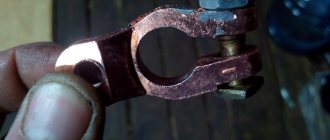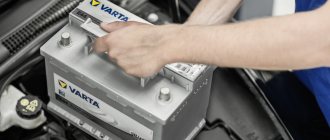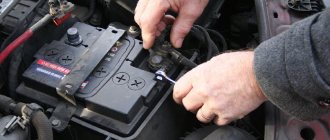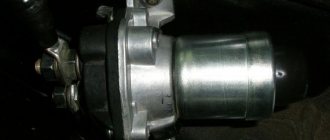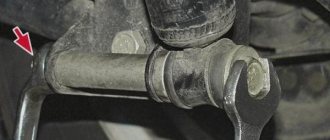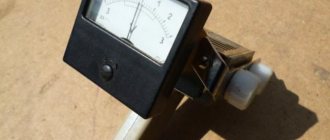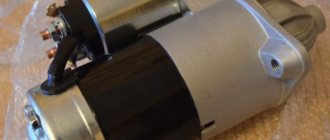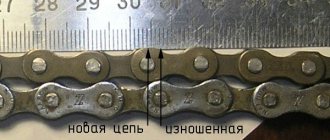The limited life of a battery does not mean that it can fail due to deterioration of the plates or electrolyte. Quite often, the car does not start due to loose contacts, but occasionally a malfunction such as a broken battery terminal occurs. Do not rush to throw away the battery in such cases: replacing the terminals is a simple operation, and any even more or less experienced motorist can cope with this problem on their own. Today we will tell you how to restore a broken battery terminal.
Restoring a car battery terminal with your own hands - Metalist's Guide
Over the course of its life, the electrical heart of a car may require “treatment.”
When the breakdown occurred due to a manufacturing defect and during the warranty period, then the question of replacement is obvious. If this happens or due to improper operation, storage or physical impact on it (impact during an accident), then the choice remains small.
In some cases, the battery cannot be restored and must be replaced, but some damage is completely removable depending on desire, availability of direct hands or lack of finances to purchase a new one.
Types of battery damage
Repairing a car battery, depending on its type (antimony, calcium, hybrid) and the severity of the breakdown, can be done either in your own garage or by contacting a service station. Battery breakdowns are divided into internal and external. The most common battery problems include:
- damage to the battery case, electrolyte leakage;
- damage to the active plates of the battery;
- short circuit of the battery plates;
- rupture of the internal circuit of the battery (breaking off, burning out of the output terminals);
- sulfation of active battery plates;
- rupture of the internal battery circuit.
Hull repair
Damage to the battery casing can occur either from an impact due to an accident, a fall, or from forgetting a “dead” battery in the cold, which will simply “break”. If the electrolyte freezes, the consequences will be further complicated by the fact that the ice will damage the active plates of the battery and it will not always be possible to fix this.
Methods for eliminating cracks
If the crack is small, then using plastic (overlay or cut flat electrodes) and a hot blower or soldering iron you can solder this place. The work is painstaking; it is necessary to ensure complete sealing of the housing.
Instead of a blower, you can also use a hair dryer, although as a rule it is equipped with protection and its operating time is limited (you will have to take breaks). Since the interior contains an aggressive environment (sulfuric acid solution), adhesive methods for sealing cracks are inappropriate here.
Soldering sequence
Soldering should be done in 2 passes. First, the crack itself is soldered, then a patch is applied and soldering is repeated. The tightness of the battery is checked by pouring distilled water into it. If everything is done correctly, then electrolyte is added instead of water and the battery is ready for use again.
If a crack is detected in the battery case, you should look where the electrolyte has spilled under the hood and neutralize these places with alkali for 10 minutes (1/2 pack of baking soda per bucket of water) to avoid further corrosion of the parts by acid. Bloated paint is not the end result; there may be acid underneath.
Restoring battery terminals
If the battery contacts are deeply oxidized and the integrity of the terminals is damaged, the connection to the vehicle's on-board network deteriorates. There is a loss of battery energy due to breakdown of the oxide (up to 50% of energy).
Read also: How to restore a laptop battery?
DIY terminal repair
In this case, repairs are made by cleaning the terminals with sandpaper and replacing the tightening clamps with new ones. If the battery terminal is completely or partially broken, some people turn to a service station, but it is quite possible to repair the car battery yourself.
Terminal disconnection
When tearing off the terminal inside the battery case, a small piece of the pad with the upper part of the terminal is cut out and removed. A hole (Ø≈8mm) is drilled in the upper (broken off) and lower (remaining) parts of the terminals for the twisted and tinned wire. The upper part of the terminal is drilled through, the lower part is 1-2 cm deep.
Drilling the terminal
When drilling the lower part of the terminal, it is necessary to cover the area with a rag to avoid drilled pieces of lead from getting into the battery grids.
The end of the wire is inserted into the lower segment of the terminal and soldered. The upper part of the terminal is placed on the wire, it is cut to size and soldered in this part.
The cut places in the plastic under the terminal are either sealed with plastic or covered with resin.
Restoring a missing terminal
To restore a terminal that is missing (to the base) from above, you will need a carbon electrode (a rod from a 373 battery will do), a wire with a cross-section of at least 4-6 mm, lead and a mold for the circumference of the terminal. A mold is placed on the existing remainder of the terminal, lead is placed into it in small portions and soldered with an arc from a carbon electrode.
Welding power source
Some use the same battery as a current source for welding, connecting a wire with an electrode to the second terminal and “shorting” the battery to the extension terminal with a carbon electrode. This is not recommended.
Firstly, after such loads, the service life of the battery is shortened, secondly, for this it must be fully charged and have sufficient capacity to heat the electrode, thirdly, this is unsafe, since for the battery to work, it must contain electrolyte and the lids of the cans must be opened during avoiding explosion.
It would be more correct to have a second current source (battery, charger, etc.) to which a mold (conductor) for filling will be connected and a carbon electrode to the second pole.
By gradually soldering lead in small portions, the terminal is brought to the required size and processed depending on the configuration of the terminals of a given battery (for example.
flat terminals with holes).
Read also: Car battery maintenance
You can use a gas torch and a hair dryer to melt lead, but in these cases it is necessary to monitor the heating of the plastic around the terminal so that the seal of the battery is not broken.
If you simply melt and pour the entire volume of lead into the mold at once, then the connection with what is left of the terminal will not warm up well and will not last long.
Restoring a small section of a terminal
If it is necessary to restore only a small piece of the terminal (no more than 50%), you can use another extension method.
To do this, 2 holes Ø4-5mm are drilled in the extension part and a prepared lead washer of the required diameter and tightened with self-tapping screws or simple screws.
In order for there to be good contact between the parts being pulled together and no oxidation, the adjacent parts must be lubricated with a conductive lubricant.
Elimination of sulfation
The most common battery malfunction is sulfation, loss of capacity. Lead sulfate dissolves when the battery is charged and is formed when it is discharged.
With constant “chronic” undercharging of the battery and its deep discharges, lead sulfate settles on the surface of the active plates and, due to this interference, the electrolyte cannot penetrate into the cells; a certain area of the plate grids does not participate in the reactions. This is the process of sulfation.
Methods for eliminating sulfation
It is easiest to repair batteries with sulfation in the initial stages. In deep stages, it is usually beyond repair. Desulfation is performed using the following methods:
- chemical (fastest);
- rinsing with water followed by charging;
- charge/discharge method;
- use of reverse currents.
Chemical method
With the chemical desulfation method, the electrolyte is drained from the charged battery, it is washed with distilled water and filled with a solution of water, 5% ammonia and 2% Trilon B used for flushing systems. A reaction will occur, producing gases and splashing. When it runs out, you need to drain the flush, rinse the battery with water, fill it with electrolyte, and charge it.
Flushing
Washing with water and then charging will take a very long time, from several weeks. Instead of electrolyte, distillate is poured in and the battery is charged at 14V.
The purpose of charging is to maintain a constant slight release of gases (boiling). The sulfate will dissolve and the density of the water will gradually increase. This water is drained, refilled with clean water and charged again.
When the water density remains unchanged for several days, desulfation is complete.
Read also: Is it possible to charge the battery without removing it from the car?
Charge/discharge
The simplest and most accessible method of desulfation is by performing charge/discharge cycles.
The battery is fully charged (with a current of 10% of the capacity) and then discharged by the consumer, who takes no more than 10% of the battery capacity, preferably with a car lamp.
When the battery voltage reaches 10.2V (full discharge), it must be fully charged again. Sulfation and internal resistance of the battery will decrease.
Application of reverse currents
If there is a reverse current generator, then desulfation can be performed with low currents (0.5-2A) until the voltage at the terminals and the density of the electrolyte remain constant for several hours. The process may take up to 2 days or more.
Elimination of short circuit of the battery
The most labor-intensive and technically complex repair is the short circuit of the battery cans.
It is possible to identify a jar with a short circuit when charging (it does not boil) or by measuring the density of the electrolyte (zero).
In 9 out of 10 cases, such a battery must be replaced, since the plates fall off and its life has already been exhausted. There are several reasons for a battery short:
- active battery grids crumbled;
- a “growth” of lead appeared on the negative electrodes;
- can separators collapsed;
- Debris appeared at the bottom of the battery, which caused a short circuit.
In the case when a short circuit occurs due to debris at the bottom of the battery, it is simply washed. On serviced batteries (antimony), you should sort out the plates or replace the can.
To do this, you need to remove (cut off) the battery cover, drain the electrolyte, wash the plates, unsolder the can with the short circuit and inspect all the plates. Most modern batteries (calcium, gel, hybrid, etc.) are not suitable for such “surgical” interventions.
Oxidation Cleaning
Cleaning the terminals from oxide is probably the easiest way. There are even special devices for this. On one side it has a repair for current leads, and on the other side there is a reamer for cleaning the inside of the contacts.
However, for an ordinary car enthusiast, owning such a device is not critical. If it is good, but not - the question of how to clean the battery terminals is easily solved. To do this you will need:
- metal brush;
- fine sandpaper.
Cleaning up oxidation is generally simple. The main thing is not to overdo it and not erase the lead. When the metal starts to shine, you can finish.
And also, if you have already started getting rid of oxide, do not forget to wash the battery itself. The main reason for the appearance of white deposits is the release of electrolyte vapors through cracks near the contacts. Therefore, a sediment of sulfuric acid could well have accumulated on the body itself. And if this is the case, there will be large current losses.
There is one good option for washing the battery; you will need a regular soda solution. It is done like this:
- take warm water;
- 10% baking soda is added to it.
The body should be washed with a well-wrung out cloth. The most important thing is not to overturn the car battery.
By the way, when oxidation appears on the contacts, the question of how to clean the battery terminals is not so important. It is much more important to determine the reasons why it appeared and eliminate them immediately.
After cleaning, it is advisable to check the battery charge level - it is quite possible that it will need recharging. If you don’t know what current to charge it with, it doesn’t matter. The battery labeling will help determine it. The maximum current should not exceed 10% of its capacity. Those. for 70 Ah, the current is set to no more than 7 A.
How to restore a battery terminal with your own hands in a garage
The current collecting leads or terminals on batteries are made of soft and fusible lead. This is done for a reason - in the event of a short circuit, the terminal will simply melt and the circuit will break.
This is very convenient, but due to the softness of the metal, the terminals may need to be repaired during battery operation. Current collecting terminals can oxidize, break, or burn out.
Let's find out how to restore the battery terminal.
When repairs are required
This is most common on trucks. The need for repair will be indicated by poor contact with the battery wires. Since large currents flow in trucks, in areas with poor contact the terminal burns and melts.
At one point, the current collector either breaks off or melts completely. This can often happen when a car owner connects two batteries in series and there is poor contact at the junction of one of the batteries.
The second common case follows from the first. The terminals are destroyed due to poor contact of the battery negative wire with the car body. People call this “bad mass.” If the contact with ground is unreliable, then the positive contact heats up and burns out or requires repair.
The third case when a car battery needs to be restored is mechanical damage to the terminals. There are many options for damage.
More often it happens that the battery is installed on the car, then the contact terminals with wires are put on. Then tighten the bolts on the terminals tightly with a wrench to achieve better contact.
When the bolt is already sufficiently tightened, the car owner tightens it again and again. The current leads are made of lead, and from such force influences they bend and break off.
Here is another popular example of mechanical damage. The battery is not secured under the hood of the car. And when the driver drives on the roads, the battery dangles the way it wants and bounces merrily on bumps. The car owner has no idea what might happen to him. But often the terminals cannot withstand such abuse and break.
The last option is short circuits. As a result, huge currents are generated that can melt not only lead terminals, but also a wrench at “13”.
How to restore the battery
So. There is a relatively new or simply well-functioning battery, but without one or two terminals. No problem - everything can be repaired. Experienced motorists offer effective methods and share secrets on how to restore a battery terminal. In this case, the terminal will be no worse than the factory one.
Deposition of POS-30 solder
To work you will need a powerful soldering iron. Solder is an alloy of lead and tin. POS solders, including this option, melt when the temperature reaches 183 degrees. Also for work you will need a special shape similar to the diameter of the terminal. Using a soldering iron, melt the solder into a mold and fuse it onto what is left of the terminal on the battery.
This method is definitely good and deserves respect; POS-30 solder has low melting temperatures, and compared to analogues, it is not dangerous for polypropylene cases of modern batteries.
Among the disadvantages of this method is the fusing process itself. The temperatures that are sufficient to melt factory lead-antimony terminals are higher than the melting point of POS-30.
In this case, a strong connection of the new terminal with the rest of the old one will not work. This renovation deserves the right to life, but it is more decorative.
Even if it is possible to connect wires to the battery, under the influence of vibration and heating from high inrush currents, such a restored terminal will collapse within a few months.
Antimony solders POSS
Here's how to restore a battery terminal using other materials. You can use solder, or you can use old sawed-off current collectors from worn-out batteries.
Apply solder slowly with a soldering iron; this is preferable to pouring molten alloyed lead. In the first option, there is a possibility that the remnants of the factory current collection will melt and a metal-to-metal connection will occur.
If you quickly pour lead, then what is left of the old terminal will not have time to heat up and again you will end up with a fragile decorative repair.
The disadvantage of this restoration of battery terminals is that the melting temperatures are too high compared to the melting point of the polypropylene from which the battery case is made.
It is important to carry out the work very carefully so as not to burn the battery cover. Liquid lead will very quickly leak inside the battery and short-circuit the battery.
Even if a short circuit does not occur, the contact between the housing and the current terminal will not be tight and the electrolyte will escape from the housing, and the terminals will oxidize.
Garage technologies
Here's how to repair a battery terminal using a graphite electrode and lead. This is the most barbaric method, but accessible and inexpensive. He is barbaric in relation to the battery being repaired.
The bottom line is that the current collector terminals are connected to each other in short circuit mode. The only resistance in this circuit is the graphite electrode.
You can gut a thick AA battery or use an old starter brush. The solder is melted into a shape similar in diameter to the terminal. Melting occurs with an electric arc.
Such battery repairs can be carried out even in the field, but you need to remember that a weak battery will not allow an electric arc to ignite.
Conclusion
This is how you can repair broken or melted terminals. Most people use the graphite electrode method. But you need to remember that such repairs are still short-lived and cannot be as reliable as at the factory. If the current collector terminals have been repaired, you need to lubricate them with grease to prevent the terminals from oxidizing in the future.
Reiterovsky Sergey
Garage technologies
Here's how to repair a battery terminal using a graphite electrode and lead. This is the most barbaric method, but accessible and inexpensive. He is barbaric in relation to the battery being repaired.
The bottom line is that the current collector terminals are connected to each other in short circuit mode. The only resistance in this circuit is the graphite electrode. You can gut a thick AA battery or use an old starter brush. The solder is melted into a shape similar in diameter to the terminal. Melting occurs with an electric arc. Such battery repairs can be carried out even in the field, but you need to remember that a weak battery will not allow an electric arc to ignite.
Battery terminal repair
A situation occurs when the terminal burns out due to weak contact strengthening. Truck drivers are more likely to encounter the problem of breakdowns, as large batteries are fixed. It is expensive to throw away the main component, so you should first try to restore the battery terminals.
Battery terminal prevention
The battery requires preventive maintenance. During active use, dirt and oxidation negatively affect the condition of the battery device. Oxidative formations appear on the housing as a result of electrolyte leakage, which negatively affects the contact of the battery and wires. If the fault is not eliminated in time, the car will stop starting.
During the Soviet era, special chemicals for car care were not produced, so many car enthusiasts used grease. Among the main functions of a lubricant (for example, litol) are:
- Prevention of oxidative processes.
- Formation of a protective mechanism against the adhesion of dirt and moisture into the contacts.
- Resists corrosion.
You can use grease or petroleum jelly for technical purposes so that the terminal retains its technical characteristics and continues to function normally. Among the innovative means, car owners use substances in aerosols, varnishes, and silicone grease. Modern compositions have a number of advantages compared to the classics:
- Presence of a dense structure.
- They remain on the body during washing.
- Retains functions and properties for a long time.
If the composition is thick, it is recommended to use a brush with soft bristles to keep your hand clean. Some products are difficult to wash off the skin and have an unpleasant odor.
Oxidation Cleaning
There is a myth that oxides are formed only in old-type batteries. In fact, the modern battery suffers less intensely. There are several cleaning methods:
- Using sandpaper.
- A rag soaked in water.
- Using a soda solution.
Replacement
If it cannot be repaired, it will need to be replaced in order to continue using the battery. First you need to disconnect the battery. It is important to follow the sequence so as not to damage the car’s electronics. The negative terminal is disconnected first, and then the positive terminal.
The terminals are disconnected from high-voltage wires. If they are attached using special clamps, first loosen the structure and then pull out the wires. As an alternative solution, you can cut the wires, first measuring the length so that it is enough to reach the battery.
As soon as dismantling is completed, be sure to check the condition of the wire insulation and then install new ones.
Important: when installing the battery, you will need to connect them in the reverse order. First the terminal with a plus, and then with a minus. Pre-clean the electrodes.
Design selection
The modern market offers a wide range of battery terminals. Before replacing, it is important to make the right choice:
- Its size must match the battery electrodes. Otherwise, it will not tighten properly and will fall out of the system, causing a malfunction. It is recommended to select the dimensions so that there is up to 5 mm left after tightening.
- The correct diameter in the hole for the high voltage wire. The fastening should be tight and adjacent to it.
It is recommended to choose structures made of lead as a material: high current conductivity, soft for crimping. It is not so often found on sale, so as an alternative, you can use models made of brass or copper.
There are also kits with wire on the market. This is the optimal solution, but requires advanced knowledge.
Restoring battery terminals
Before making a replacement, it is recommended to try repairing the battery terminal. There are two effective ways to restore a car battery terminal yourself:
- Melting lead and tin in a pre-prepared metal container, preparing a mold from a finger-size battery. Clean the terminal and its location. Melt it by pouring it into the mold. Use pliers as a fixative and get rid of the excess.
It is advisable to use this method if the terminal is completely burnt. If the structure has fallen away from the ACT, then it is recommended to restore it using the second method.
- Fuse it and lead using a rod from a salt battery. Use her body as a mold. It is recommended to keep a soldering iron on hand. From an aesthetic point of view, this method is less acceptable, but it is convenient to use if a malfunction occurs on the road and urgent repairs are required.
Each car enthusiast uses his own method. The main thing is to follow safety measures. If repair is not possible and replacement is required, it is important to disconnect the terminals in the correct order. Otherwise, there is a possibility of causing irreparable damage to the electronic control of the car, which requires expensive restoration measures.
Recovery methods
Some motorists believe that if the current collector terminals are deformed, the only solution to the problem will be replacement.
But there is no need to rush into replacement. Sometimes the terminals can still be restored.
There are several options on how you can restore the battery terminals with your own hands.
- Melt lead and tin. The metal of the terminals should be melted in a previously prepared metal container. A mold made from a AA battery is suitable. The terminals and the area around them should be cleaned. Melt the metal and pour it into the mold. Clamping the workpiece in pliers, the excess is removed. This method is suitable if the terminal is completely burnt.
- If the structure falls off the battery, the second restoration method is suitable. To do this, you need to fuse the terminal with lead using the core of a salt battery. The body will be used as a mold. A soldering iron is required. The method is suitable for urgent repairs.
But there are also situations when we are not talking about restoration. Here the only way out of this situation will really be a replacement.
How to restore a damaged battery? Restoring the terminals
Surely every motorist has at least once encountered the problem of a burnt battery terminal. Also, some people encounter a problem when the terminal breaks off or melts completely (this also happens, but rarely).
Be that as it may, with such damage, the battery can no longer be used, since the terminal block will either be poorly attached (which will lead to sparking and further melting) or there will simply be nothing to secure it to (if the terminal has fallen off or completely melted).
So the main question of this article is how to restore battery terminals .
Craftsmen have come up with two ways to restore battery terminals . Actually, we will consider them, and also estimate what the advantages and disadvantages of each method are.
But before you start restoring the terminals, the damaged terminal must be thoroughly cleaned of soot, oxides, and in general it is advisable to clean the old lead.
When the terminal is completely cleaned, you can proceed to selecting the restoration process.
https://www.youtube.com/watch?v=H7ZaWU6WT-I
For each of the methods we need lead . It can be obtained from fishing weights, but if they are not available, you can take solder with a high lead content, for example, POS-15, POS-25 or any other where there is more lead than tin. It is also advisable to have a knife, a file and fine sandpaper, pliers and a tin can (from coffee, beer, or anything at all).
Cut out a shape for the future terminal from tin . To do this, it is recommended to actively use the entire terminal and the terminal block itself, which will be placed on the damaged terminal. Make a mold, align its walls so that it is in maximum contact with the terminal block. By the way, the terminal block itself must be opened before starting the procedures.
And so, the lead is there, the mold is ready, which means it’s time to start restoring the terminal .
Method No. 1
- Melt lead over an open fire. A gas burner or soldering iron is also suitable for these purposes.
- Place a repair mold on the damaged terminal.
- Pour the lead into the mold.
- When it cools and hardens, remove the tin form.
- Clean the terminal with a file until it is shiny. It should be in perfect contact with the terminal block.
The advantages of this method are its simplicity. You can also melt lead over a regular fire .
Even if such a problem happened on the road, finding some branches and starting a fire is not a problem.
disadvantages - the lead for restoration and the actual lead of the terminal will have a different composition and after some time such a lead “implant” may fall off , crumble or disintegrate. This method of restoring a terminal is only good if others are simply unavailable.
Method No. 2
For this method you will need several batteries , as well as a thick copper wire with insulation and an alligator clip. Connect the wire to the crocodile.
Disassemble the AA battery using a knife and pliers and remove the carbon rod from it. Connect it to the free end of the wire.
This entire structure must be connected to the entire battery terminal.
- Place a repair mold on the damaged terminal.
- Throw a few pieces of lead into the mold and place the connected rod there. It will begin to spark and heat up, melting the lead. This is normal, this is how it should be.
- Gradually fill the mold with lead. Use the rod to stir the lead so that the terminal metal mixes with the one you are adding.
- When the terminal is welded, clean it.
This method also has its certain disadvantages. One of the main ones is that if trouble with the terminal happens on the road, you need to get a battery somewhere . Also, all manipulations with surfacing must be done as quickly as possible, since this method uses up battery power quite quickly .
But there are also advantages :
- If the lead is mixed, the terminal will be homogeneous and strong, it will not fall apart or crumble.
- The whole process takes little time. With some experience, the terminal can be restored in just a few minutes.
- The finished wire with a carbon rod can be placed in a toolbox and taken with you.
If you want to avoid melting or destroying the terminal, just secure the terminal block well to the terminal. It is because of poor contact that sparking occurs and, as a result, melting of the terminal.
Also, you can apply some kind of oil, for example, Litol, to the restored terminal, which will help avoid oxidation of the terminal.
Terminals of low-power motorcycle batteries and UPS
If a terminal falls off a motorcycle battery or switching power supply, it is restored in the same way. But the terminals themselves can be of different configurations. Therefore, after manufacturing, it should be modified to connect wires. For example, some models require a hole for a screw. To do this, you can use a metal drill. You can purchase a separate clamp that is installed on the battery. And a standard connector for connecting electrical wiring is attached to the clamp itself.
It should be taken into account that the capacity of such batteries is much less than car batteries. Therefore, the risk of electrolyte boiling is much higher. It is necessary to ensure high-quality cooling of the battery during fusing. In this case, it is not worth using the discharge current of the battery itself. Its capacity may not be enough, and a deep discharge will lead to irreversible destruction of the battery plates.
DIY battery repair
Over the course of its life, the electrical heart of a car may require “treatment.” When the breakdown occurred due to a manufacturing defect and during the warranty period, then the question of replacement is obvious.
If this happens due to improper operation, storage or physical impact on it (impact during an accident), then the choice remains small.
In some cases, the battery cannot be restored and needs to be replaced, but some damage is completely removable depending on desire, availability of direct hands or lack of finances to purchase a new one.
Types of car battery damage
Repairing a car battery, depending on its type (antimony, calcium, hybrid) and the severity of the breakdown, can be done either in your own garage or by contacting a service station. Battery breakdowns are divided into internal and external. The most common battery problems include:
- damage to the battery case, electrolyte leakage;
- damage to the active plates of the battery;
- short circuit of the battery plates;
- rupture of the internal circuit of the battery (breaking off, burning out of the output terminals);
- sulfation of active battery plates;
- rupture of the internal battery circuit.
The first sign of the need for battery repair is its rapid charging and equally rapid discharge when trying to start the engine. The reason for this may be a low level of electrolyte in the banks.
To correct this, you will need to measure its density with a hydrometer, which should be from 1.23 to 1.3 g per cm2.
If the density is too high, the electrolyte should be diluted with distilled water, since most often it evaporates through breathers (holes in the covers) during charging and operation of the battery.
Restoring battery terminals
If the battery contacts are deeply oxidized and the integrity of the terminals is damaged, the connection to the vehicle's on-board network deteriorates. There is a loss of battery energy due to breakdown of the oxide (up to 50% of energy).
Repairing a short circuit in the battery
The most labor-intensive and technically complex repair is the short circuit of the battery cans. It is possible to identify a jar with a short circuit when charging (it does not boil) or by measuring the density of the electrolyte (zero). In 9 out of 10 cases, such a battery must be replaced, since the plates fall off and its life has already been exhausted. There are several reasons for a battery short:
- active battery grids crumbled;
- a “growth” of lead appeared on the negative electrodes;
- can separators collapsed;
- Debris appeared at the bottom of the battery, which caused a short circuit.
In the case when a short circuit occurs due to debris at the bottom of the battery, it is simply washed. On serviced batteries (antimony), you should sort out the plates or replace the can.
To do this, you need to remove (cut off) the battery cover, drain the electrolyte, wash the plates, unsolder the can with the short circuit and inspect all the plates. Most modern batteries (calcium, gel, hybrid, etc.) are not suitable for such “surgical” interventions.
Due to the fact that there is a sulfuric acid solution inside the battery, such repairs as eliminating a short circuit will require certain knowledge, skills and compliance with safety regulations. When working with acid, the hazard class is high. It's better to leave this to the professionals.
How to restore a closed can in a battery is shown in this video:
Why do terminals deteriorate?
The following items can be identified as the main reasons for damage to the battery terminal:
- physical deterioration. If the car has been in use for decades, and the battery is constantly reconnected, then we can talk about the risk of damage to the connection elements.
- electrolyte got onto the contacts. This usually occurs due to insufficiently tightened rods or a loose battery plug;
- Electrolyte density does not meet standards. A similar reason is relevant if the car owner dilutes the acid himself;
- seal failure, damage to the battery shell. The result is an electrolyte leak or a short circuit in the battery section;
- constant problems with the electrical network in the vehicle.
- melting of terminals.
Most of the above factors can be eliminated without unnecessary problems - it is enough to check the condition of the battery at least two or three times a week, and if problems arise, immediately eliminate the source, rather than try to deal with the consequences.
Prevention
Repairing a battery terminal is a troublesome task. In addition, even after the highest quality repairs, a new one will not last long. At best, up to six months. The factory terminal of the pole consists of two elements, the central terminal and the cap, between which there is a gap. This design makes it easier to withstand vibration and the compression force of the terminal with a snap-on clamp. The new pin is a single rigid pin, not suitable for vibration.
Therefore, in order to prevent serious damage to the battery terminals, it is necessary to monitor their condition. To do this, you need to periodically inspect them, once every 3 months is enough, when the battery itself is serviced.
If traces of salt deposits, sparking, or corrosion of terminals and clamps are detected, they should be cleaned with a rag, using baking soda or soda ash diluted in water, or ammonia. These substances are alkaline solutions with varying degrees of activity. They neutralize acid well and dissolve salt crystals formed under the influence of the electrolyte. Cleaned clamps can be coated with a preservative lubricant to prevent further oxidation. If the lubricant is not electrically conductive, then the clamps should only be coated on the outside when they are placed on the terminals and crimped. To prevent lubricant from getting inside and worsening the contact. It is better to use a conductive lubricant, which is useful to apply to the entire surface, including the inside, of the clamps and poles.
Electrically conductive lubricants can be purchased at car dealerships: oil-based contact cleaner CRAMOLIN CONTACLEAN, automotive lubricant LIQUI MOLY Batterie-Pol-Fett, lubricant for electrical contacts “Presto” and others.
If the terminal and clamp are heavily soiled, they should be separated and cleaned separately. The order of disconnecting the clamps is: first “minus”, then “plus”. Add in the reverse order: first “plus”, then “minus”. Cleaned pole terminals and clamps must be coated with protective electrically conductive grease. It is necessary, because once oxidation has appeared and the causes have not been eliminated, the contacts will oxidize again. And it is better to protect them with lubricant. Even if an attempt has been made to eliminate the causes of oxidation, it will take a long time to verify its effectiveness.
At the poles, electrolyte vapors can penetrate through the formed microcracks. This leads to accelerated oxidation of the contact pair. To prevent vapors from escaping, cover the surface of the battery cover around the terminal with a sealing compound. To do this, you can use bitumen mastic, silicone sealant, epoxy glue and other similar acid-resistant compounds. For example, you can cut a ring from thick felt. Impregnate the lower part of the ring with grease: litol, grease, silicone. It is put on the terminal and pressed against the lid. The ring will be pressed on top with a clamp placed on the terminal. Such a device will not allow couples to freely exit and come into contact. When applying lubricant, if it is not electrically conductive, you should avoid getting it into the contact area between the clamp and the terminal.
How to properly remove a stuck clamp from a terminal
As noted above, the clamp should not be loosened or attempted to be twisted around the battery terminal. This can cause cracks to form in the battery case cover where the lead exits the battery. There is a high probability of breaking the conclusion. There are known cases when the terminal was torn off inside the battery from the pole jumper of the plate block. In this example, it is impossible to restore it without disassembling the battery cover.
First, the bolt and nut tightening the jaws of the clamp are released. The stuck clamp should be removed from the terminal by expanding the jaws of the clamp, using a screwdriver, open-end wrench or other tool, which is inserted under tension into the groove clamped with a bolt and nut. The tool easily expands the groove and the surface of the clamp lags behind the terminal. After which the clamp is removed from the pole upwards.
Currently reading:
How and with what to clean battery terminals from oxidation
Why do the positive and negative terminals on a car battery oxidize?
Is it possible to revive an old lead-acid car battery?
Restoring a smartphone battery after deep discharge
Which terminal to remove from the battery when parked for a long time?
Repair in case of violation of the integrity of the housing
The leakage of the outer shell of the battery most often occurs due to careless handling. For example, it was damaged due to the fact that it was not securely fixed under the hood of the car
Before starting repairs, you need to determine what position the crack or chip occupies in relation to the electrolyte: above or below its level. If the damage is located below, then the electrolyte in the battery must be replaced. It needs to be drained, and this cannot be done by simply turning the battery over. The fact is that lead oxide, which collects on the walls and bottom of the battery during operation, when turned over, can cause the final short circuit of its plates, and it will no longer be possible to repair this.
In this case, you need to remove the liquid from the battery without turning it over, but take a large syringe with a PVC tube attached to it. The length of the tube should be about 25 cm.
Only after this we proceed to repair the crack in the battery as follows:
- Using a sharp knife, make a V-shaped groove along the entire length of the crack.
- We fix the ends of the crack with small holes with a diameter of 1 mm. We make them with a thin drill, this will prevent the crack from enlarging.
- We heat the metal brackets either with a soldering iron or over a candle flame to a temperature of 450°C.
- Every 12 mm we solder staples with a soldering iron along the edges of the crack (thus making a kind of bandage).
- Now we cut out an insulating sheet from a material with increased heat resistance 10x15cm, cut a hole in it, which should exactly match the size of the crack in the battery. Now you need to combine everything and secure it firmly.
- For solder you will need polypropylene strips, which will need to be prepared in advance. They are needed to seal the V-shaped gap.
- Heat the edges of the crack with a special construction hairdryer, melt the material rolled into a bundle with a soldering iron, and press it to the crack.
- Gradually heating the edges of the gap and the material, carefully solder it to the end.
Finally, you can put a patch on the crack made of polystyrene material treated in KR 30 solvent. Before gluing the patch, sand the entire surface near the crack with sandpaper and degrease it with acetone.
When might repairs be needed?
The following signs indicate that the battery in a car needs restoration and repair:
- Malfunctions of electrical equipment. The devices in the car are unstable and can turn off randomly. The optics may be too dim.
- The car battery charges quickly. This indicates a decrease in capacity, resulting in less time for recharging.
- Problems with starting the power unit. The starter cranks with difficulty, too slowly. In some cases, starting the car engine is not possible at all.
